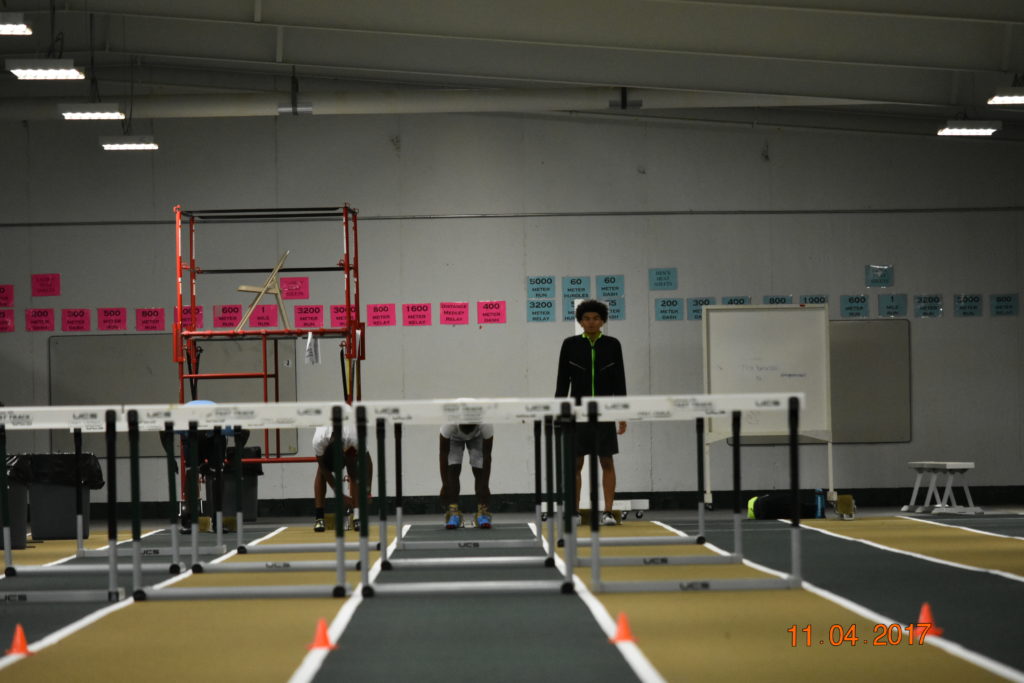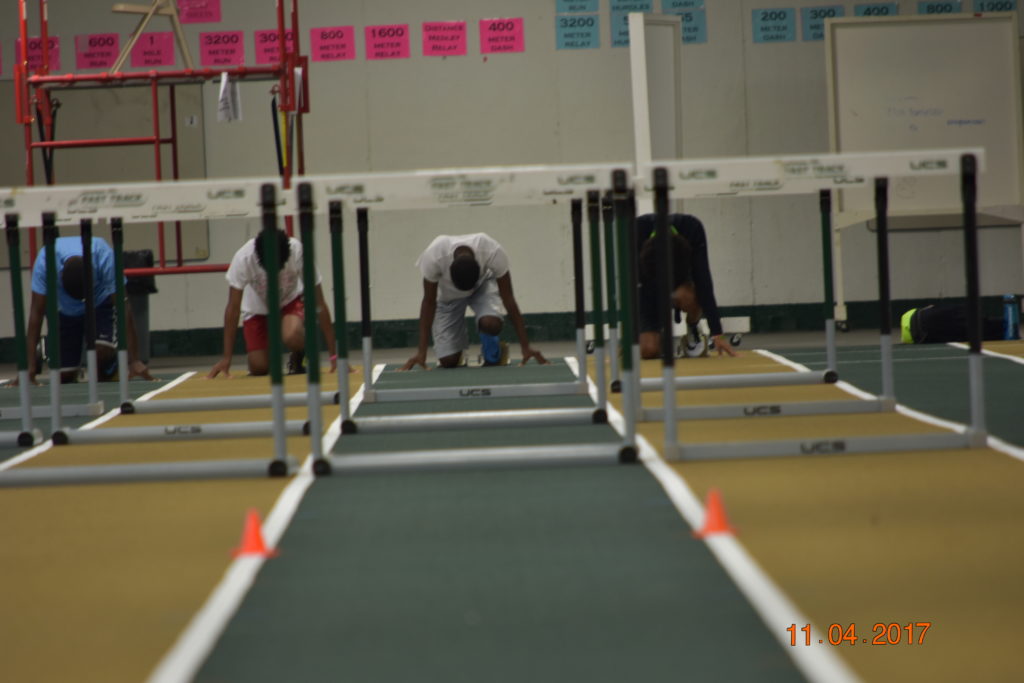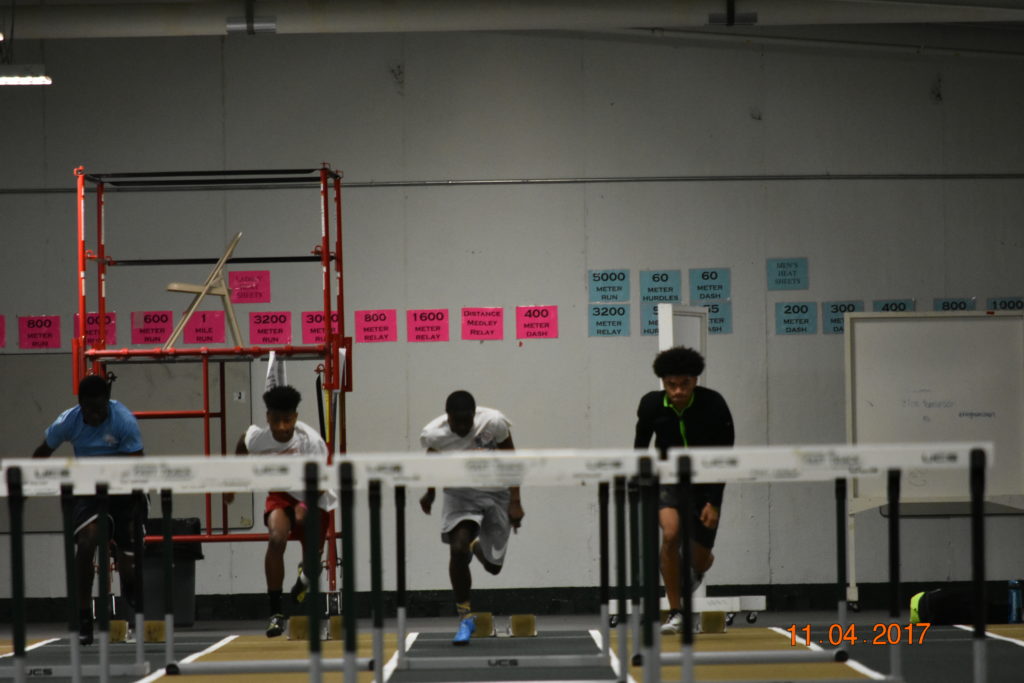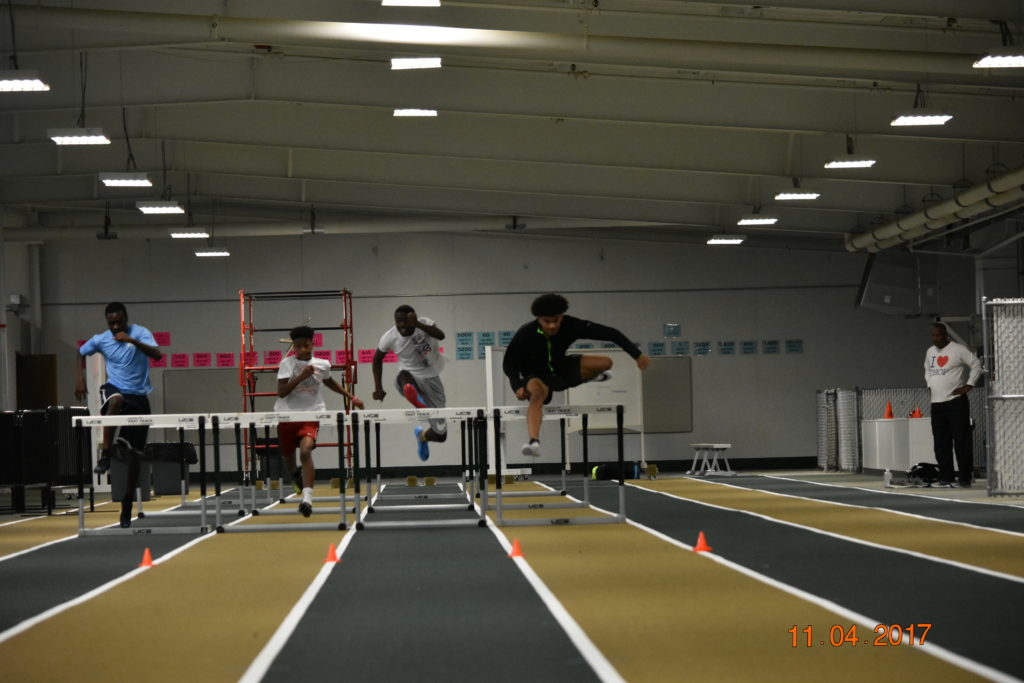Start Practice with the Fellas
by Steve McGill
Had a chance to get in some good work a great group of hurdlers two weeks ago. Three of them were high school freshmen – Alex Nunley, Matt Garrett, and Brandon Johnson. All three did exceptionally well last summer in the 13-14 year old age group in youth track (Alex and Matt finished 1-2 at Nationals in July), and all three are making the huge transition from the 33-inch barriers to the 39’s. The fourth member of the group was rising junior Joshua Brockman, who ran sub-14 in winning the 15-16 age group at Junior Olympic Nationals this past July. Alex and I go way back, I’ve been working with Matt for over a year now, and I just started working with Brandon and Joshua this fall.
[am4show not_have=’g5;’]
[/am4show][am4guest]
[/am4guest][am4show have=’g5;’]
All four of them are highly skilled and highly competitive, so I wanted to make the most of this opportunity to coach them all indoors, at the excellent indoor facility in Winston Salem, NC — JDL Fast Track — where I held my first speed & hurdle camp one week later. Because it’s expensive to rent the space for a training session, I decided that, instead of doing the usual hurdle endurance type of stuff that I usually emphasize this time of year, it would make more sense to get in some work out of the blocks, so that’s what we did.
I had them do starts hurdle-free, over one hurdle, over two, over three, and over four. All hurdle reps were done with the hurdles at 36 inches — one click below their race height of 39. Matt’s dad, Michael, took some very nice photos of the session for me, and I pulled out a few of them to analyze in this article. Let’s take a look below:
In the above photo, Alex, Brandon, Matt, and Joshua (left to right) are preparing to enter their blocks after I (the starter) instructed them to take their marks. Notice that the three younger athletes are leaning down to step into the blocks while Joshua is still standing erect, staring straight ahead. Everyone has their own ritual getting into the blocks; the important thing for younger hurdlers to understand is that they shouldn’t rush. While Joshua here is not playing any mind games, the fact of the matter is that plenty of athletes take their sweet old time getting into the blocks, and you need to be prepared for that without getting antsy or annoyed.
In the above photo, all four athletes are in the mark position. Notice the body angles of all four of them — head down, eyes down, shoulders relaxed, fingertips raised so that when they rise into set, the pressure will be on their fingertips. Although hurdlers will have to clear a barrier within 13.72 meters, they still want to have the same posture in the blocks as 100m sprinters. Hurdlers who look up while in the blocks — whether in the mark position or the set position — are more prone to popping up too soon, costing them acceleration through the first hurdle.
In the above photo, the four hurdlers have taken their first two steps out of the blocks and are accelerating to hurdle one. Everybody is pushing forward, rising toward full height. A couple of them have made eye contact with the first hurdle, which is fine, because they’re still driving, still pushing, still accelerating. My personal preference is to keep the eyes down for three full strides before making eye contact with the hurdle at step four, which is what Matt is doing. But I don’t mind if you get your eyes on the hurdle sooner if you don’t pop up when you look up.
In the above photo, the hurdlers are taking off into hurdle one. Three of the four hurdlers have already left the ground, and you can see that, for each of them, the knee of the lead leg is leading the way. That’s a basic for us. I always tell my hurdlers that we want to be hip flexor hurdlers, not hamstring hurdlers. What that means is, we want to lead with the knee and make the hip flexor do the work, not lead with the foot and make the hamstring do the work. Hamstring hurdlers are likely to suffer to hamstring strains and hamstring pulls. We also try to keep the lead arm moving up and down, not allowing the hand to cross the body.
In this last photo, Joshua, on the right, is descending off the hurdle, while the other three are still on the front side of it. Joshua does look high over the hurdle, but that’s for two reasons — one, he’s used to clearing 39’s, and two, with the style of hurdling that I teach, the lead leg comes down on the hurdle; it’s never going to be 100% horizontal. We don’t kick out the lead leg and then snap it down; we cycle it so that it moves continuously. Matt’s lead leg (second from the right) is slightly bent inward, but that’s more an indication of bow-leggedness than a hurdling flaw. Brandon’s arms (second from left) are swinging across his body some. His biggest issue is that he needs to get stronger in his core so that he can eliminate the zig-zagging in the lane that he does. With Alex (far left), his biggest issue has been strengthening his hip flexors so that he can raise the lead leg knee higher than he needed to when he was clearing 33’s.
All in all, it was a very productive day at the track, and we definitely will want to do it again soon.
[/am4show]





